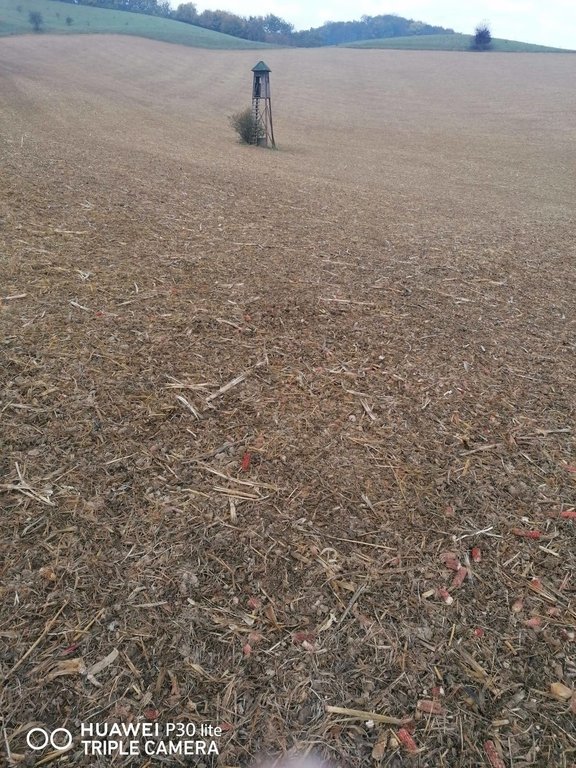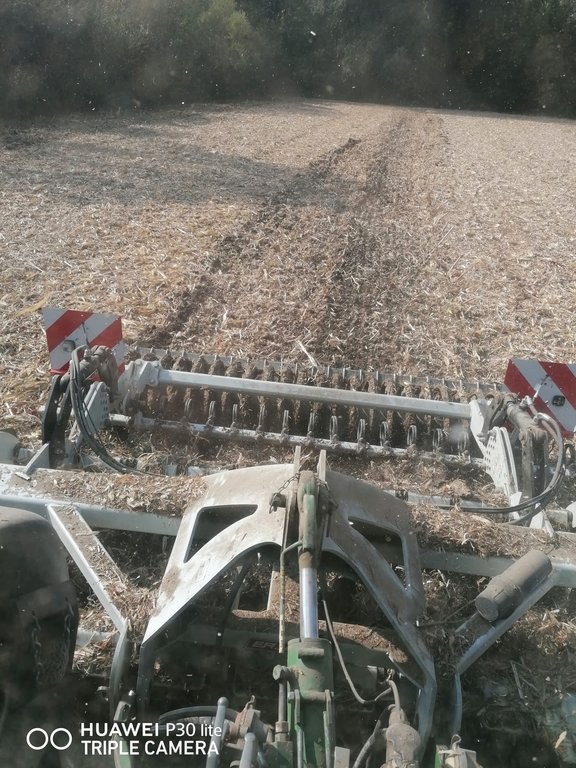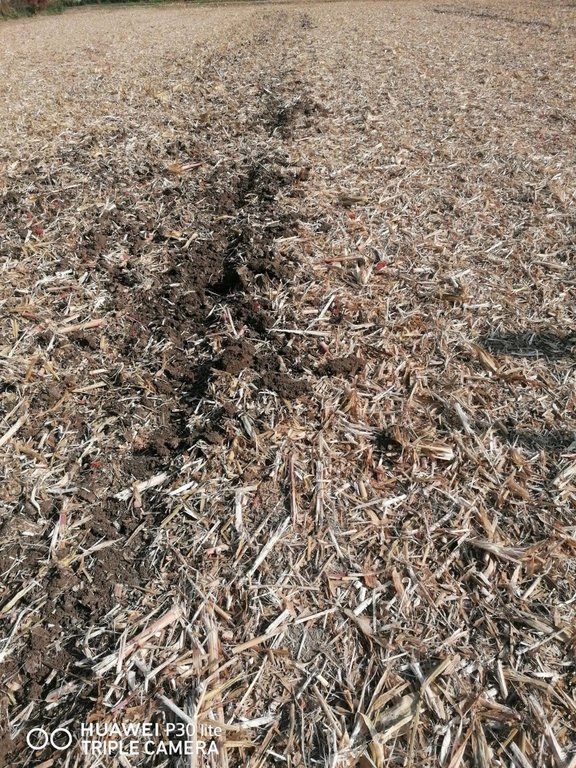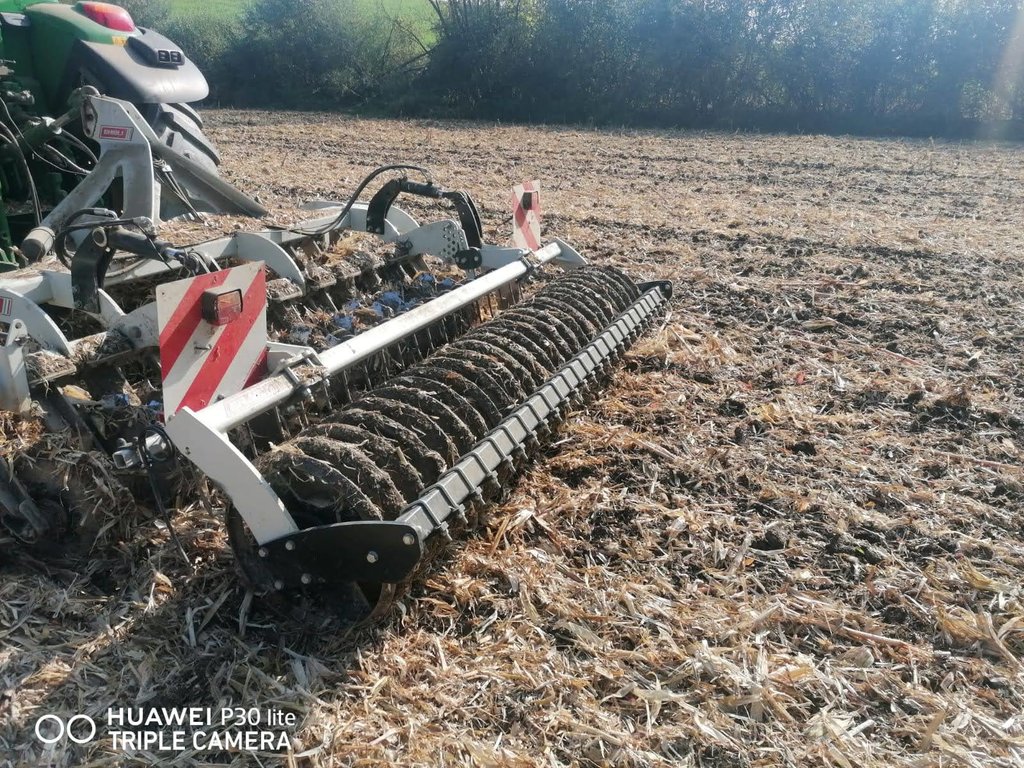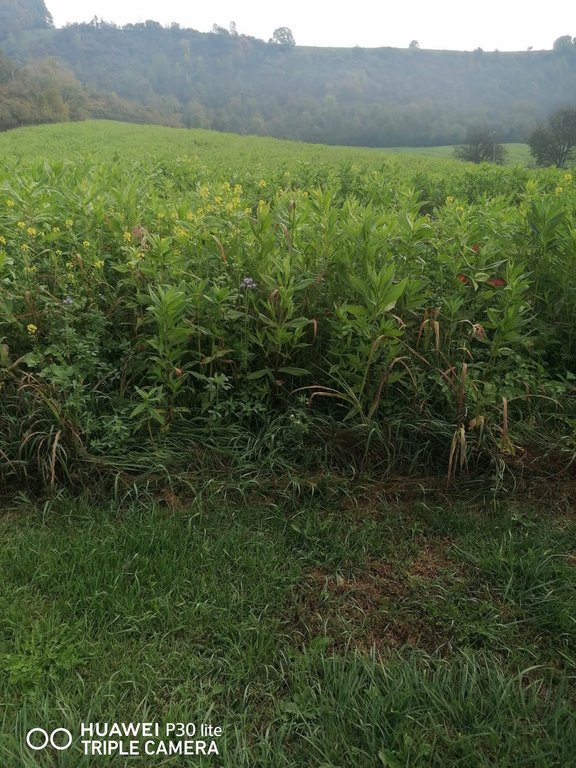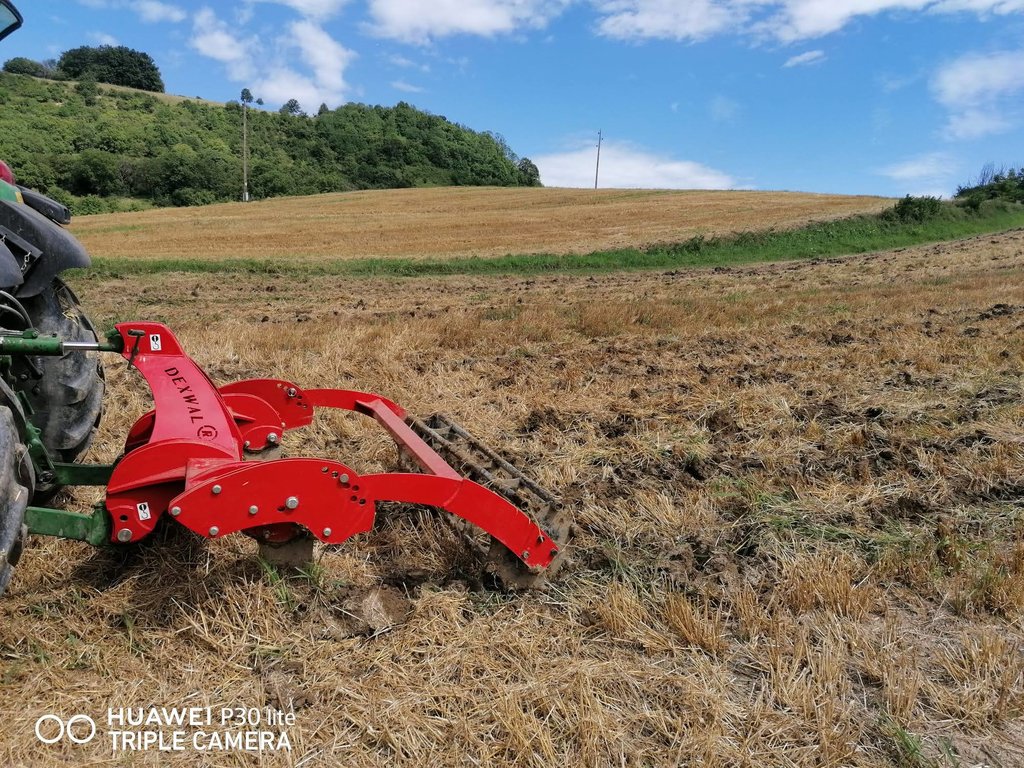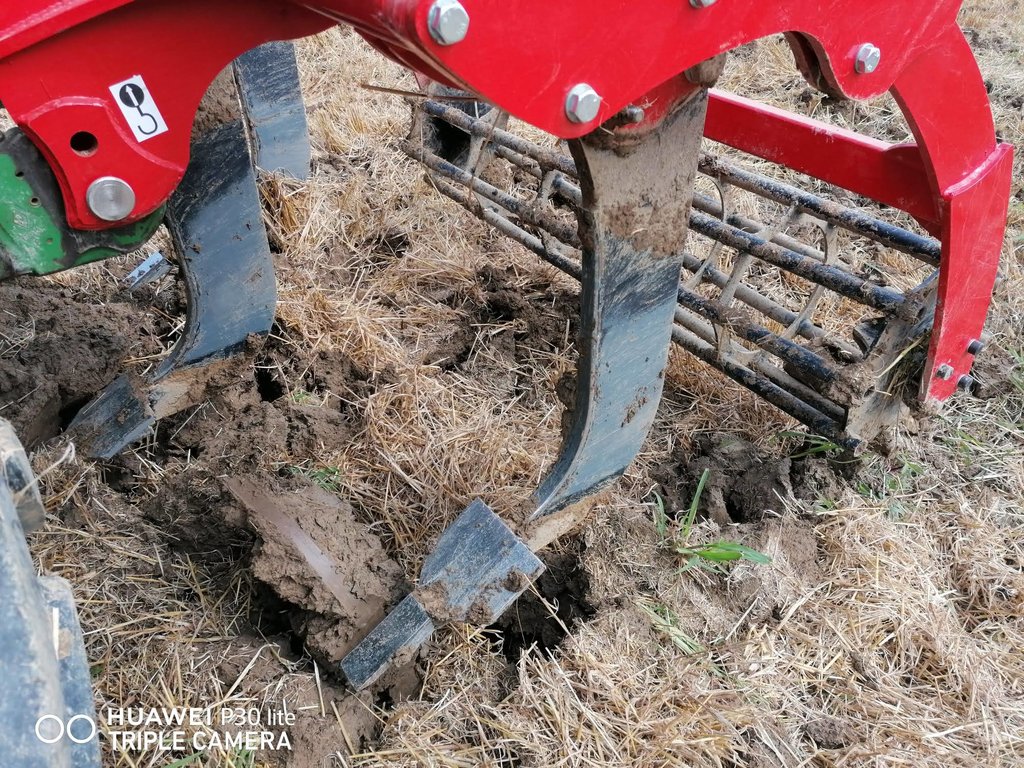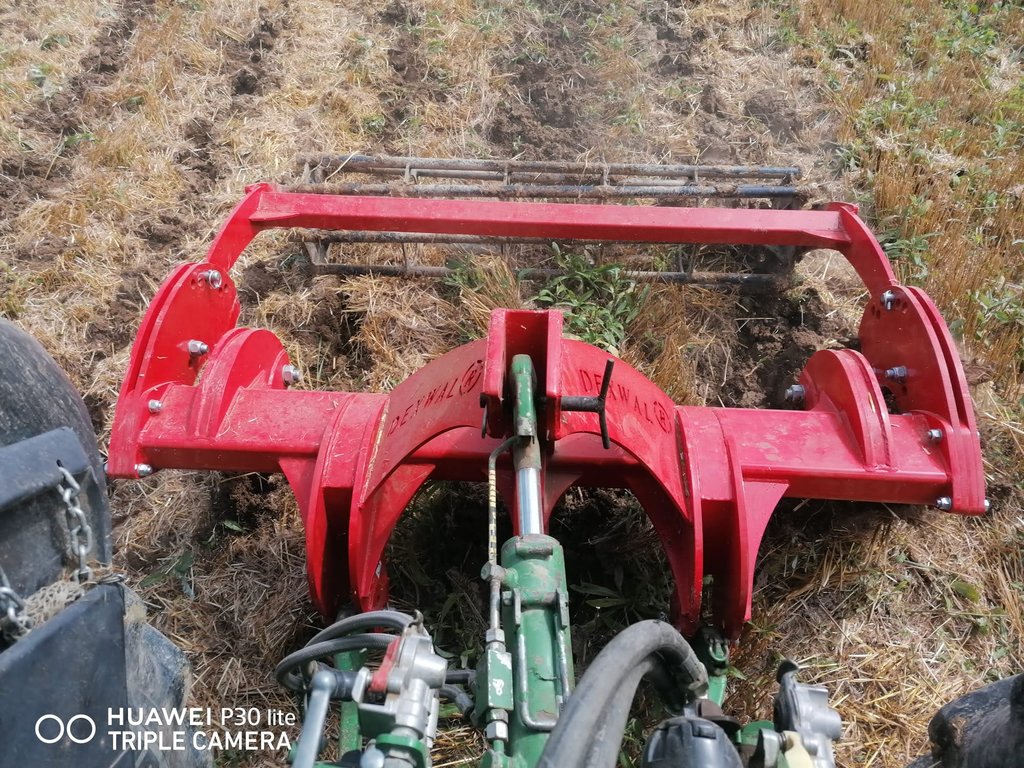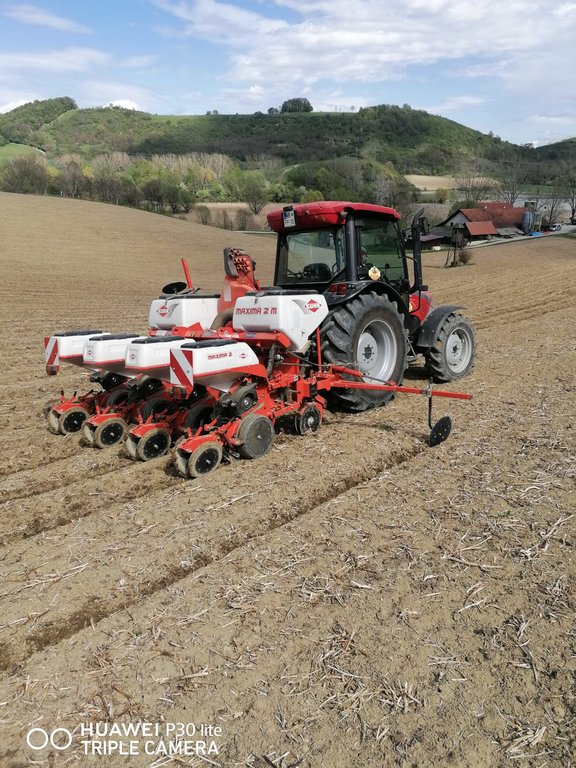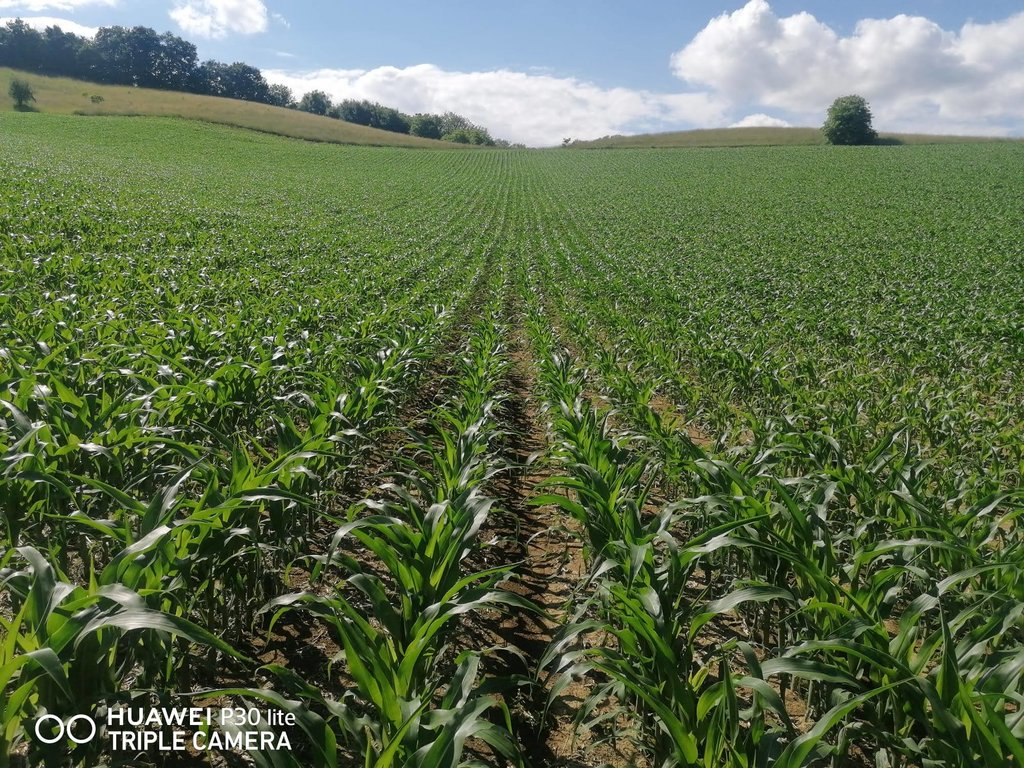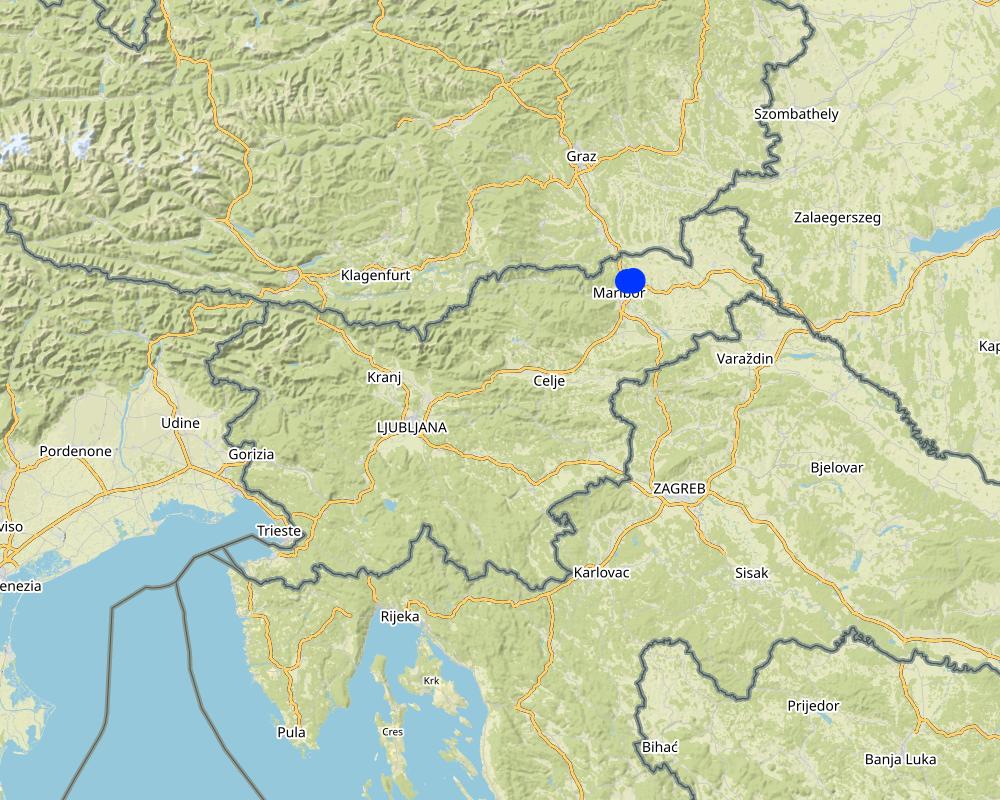Mulch-till [สโลวีเนีย]
- ผู้สร้างสรรค์:
- การอัพเดท:
- ผู้รวบรวม: Gregor Kramberger
- ผู้เรียบเรียง: Matjaz Glavan
- ผู้ตรวจสอบ: William Critchley, Rima Mekdaschi Studer
Konzervirajoča obdelava tal (mulch-till)
technologies_6241 - สโลวีเนีย
ดูส่วนย่อย
ขยายทั้งหมด ย่อทั้งหมด1. ข้อมูลทั่วไป
1.2 รายละเอียดที่ติดต่อได้ของผู้รวบรวมและองค์กรที่เกี่ยวข้องในการประเมินและการจัดเตรียมทำเอกสารของเทคโนโลยี
ผู้เชี่ยวชาญ SLM:
ผู้เชี่ยวชาญ SLM:
Curk Miha
Biotechnical Faculty, University of Ljubljana
สโลวีเนีย
ผู้เชี่ยวชาญ SLM:
Cvejic Rozalija
Biotechnical Faculty, University of Ljubljana
สโลวีเนีย
ผู้ใช้ที่ดิน:
Ropič Andrej
Farmer
สโลวีเนีย
ชื่อของโครงการซึ่งอำนวยความสะดวกในการทำเอกสารหรือการประเมินเทคโนโลยี (ถ้าเกี่ยวข้อง)
OPtimal strategies to retAIN and re-use water and nutrients in small agricultural catchments across different soil-climatic regions in Europe (OPTAIN)ชื่อขององค์กรซึ่งอำนวยความสะดวกในการทำเอกสารหรือการประเมินเทคโนโลยี (ถ้าเกี่ยวข้อง)
Chamber of Agriculture and Forestry of Slovenia – Institute of Agriculture and Forestry Maribor (KGZS) - สโลวีเนีย1.3 เงื่อนไขการใช้ข้อมูลที่ได้บันทึกผ่านทาง WOCAT
ผู้รวบรวมและวิทยากรหลักยอมรับเงื่อนไขเกี่ยวกับการใช้ข้อมูลที่ถูกบันทึกผ่านทาง WOCAT:
ใช่
1.4 การเปิดเผยเรื่องความยั่งยืนของเทคโนโลยีที่ได้อธิบายไว้
เทคโนโลยีที่ได้อธิบายไว้นี้เป็นปัญหาของความเสื่อมโทรมโทรมของที่ดินหรือไม่ จึงไม่ได้รับการยอมรับว่าเป็นเทคโนโลยีเพื่อการจัดการที่ดินอย่างยั่งยืน:
ไม่ใช่
2. การอธิบายลักษณะของเทคโนโลยี SLM
2.1 การอธิบายแบบสั้น ๆ ของเทคโนโลยี
คำจำกัดความของเทคโนโลยี:
Mulch-till is a method of farming that does not utilise a plough, and thus the soil is not turned over. Furthermore, at least 30% of the cultivated area remains covered with organic residues left over from the previous crop. There are multiple benefits to the soil and carbon dioxide emissions are reduced.
2.2 การอธิบายแบบละเอียดของเทคโนโลยี
คำอธิบาย:
Mulch-till (also called “conservation agriculture” or “minimum tillage”) is a method of land management with modified, less intensive tillage, where land is covered with plant residues year-round (at least 30% cover) or grass, energy consumption is reduced, and there is less trampling/ compaction of the soil because of fewer machine passes and the protected surface. Under mulch-till, special agricultural machinery and attachments are required. Disc harrows and chisel ploughs are used to loosen the soil, and direct drills are employed for seeding. Ploughs are not used and the soil is not inverted. This method of tillage is intended to maintain soil structure, build up humus, improve nutrient supply and soil moisture, increase soil microbiological activity and also to prevent soil erosion. Mulch-till reduces the number of work operations on the cultivated area. Because the soil is disturbed less, this minimises the exposure of soil organic matter to the air, and therefore decreases the formation and release of CO2 to the atmosphere.
The debate over whether ploughing is still necessary has been going on for quite some time. Both mulch-till and ploughing have their advantages as well as disadvantages. Research shows that mulch-till reduces soil erosion and compaction, and this has a significant impact on soil fertility. On the other hand, ploughing better inhibits the spread of weeds and certain types of diseases and pests.
Mulch-till requires complete replacement of machines/tools, and this is a considerable initial investment. Regular annual maintenance of the equipment is needed also. Mulch-till provides full benefits after a number of years, through making sure that minimal soil inversion and organic soil coverage is guaranteed. It also requires good planning of crop rotation, the use of a special seed drill and employment of herbicides after emergence (or surface hoeing). Users mention one advantage being the low costs for tillage, which is less expensive than ploughing, and the reduction of soil erosion on sloping terrain. However, they do not like the high investment for equipment, possible lost of yields and increase in weeds: all tend to arise at the beginning of implementation. Knowledge and experience are required, as the technology is quite demanding, so there are chances of failure.
2.3 รูปภาพของเทคโนโลยี
2.5 ประเทศภูมิภาค หรือสถานที่ตั้งที่เทคโนโลยีได้นำไปใช้และได้รับการครอบคลุมโดยการประเมินนี้
ประเทศ:
สโลวีเนีย
ภูมิภาค/รัฐ/จังหวัด:
Jareninski dol, Pernica
ข้อมูลจำเพาะเพิ่มเติมของสถานที่ตั้ง :
Vosek
ระบุการกระจายตัวของเทคโนโลยี:
- กระจายไปอย่างสม่ำเสมอในพื้นที่
If precise area is not known, indicate approximate area covered:
- < 0.1 ตร.กม.(10 เฮกตาร์)
Is/are the technology site(s) located in a permanently protected area?
ไม่ใช่
Map
×2.6 วันที่การดำเนินการ
ระบุปีที่ใช้:
2020
2.7 คำแนะนำของเทคโนโลยี
ให้ระบุว่าเทคโนโลยีถูกแนะนำเข้ามาอย่างไร:
- ด้วยการริเริ่มของผู้ใช้ที่ดินเอง
- ในช่วงการทดลองหรือการทำวิจัย
ความคิดเห็น (ประเภทของโครงการ เป็นต้น) :
A few years ago, the farmer transitioned from traditional plowing to a mulch-tillage technique and has been using this method since 2020. In 2021, the farmer sought assistance from a consulting service to connect with the Biotechnical faculty in Ljubljana. Tests were conducted to assess the impact of conservation tillage. Following the positive results, the farmer has continued collaborating with the Biotechnical faculty and the public advisory service, further experimenting with the technology and maintaining the new cultivation approach. Today, he is one of the prominent advocates of conservation tillage.
3. การจัดประเภทของเทคโนโลยี SLM
3.1 วัตถุประสงค์หลักของเทคโนโลยี
- ลด ป้องกัน ฟื้นฟู การเสื่อมโทรมของที่ดิน
- ป้องกันพื้นที่ลุ่มน้ำ/บริเวณท้ายน้ำ โดยร่วมกับเทคโนโลยีอื่นๆ
- ลดความเสี่ยงของภัยพิบัติ
- ปรับตัวเข้ากับการเปลี่ยนแปลงภูมิอากาศของโลก สภาพภูมิอากาศที่รุนแรงและผลกระทบ
- ชะลอการเปลี่ยนแปลงภูมิอากาศของโลกและผลกระทบ
3.2 ประเภทของการใช้ที่ดินในปัจจุบันที่ได้นำเทคโนโลยีไปใช้
Land use mixed within the same land unit:
ไม่ใช่

พื้นที่ปลูกพืช
- การปลูกพืชล้มลุกอายุปีเดียว
Annual cropping - Specify crops:
- cereals - barley
- cereals - maize
- cereals - wheat (winter)
- fodder crops - clover
- fodder crops - other
- legumes and pulses - other
- legumes and pulses - soya
จำนวนของฤดูเพาะปลูกต่อปี:
- 1
Is intercropping practiced?
ไม่ใช่
Is crop rotation practiced?
ใช่
ถ้าใช่ ระบุ:
Continuously 1 main crop: maize, wheat (winter) or barely (winter) and fodder peas or soy. After the main crop, the rotation includes cover crops (greening) which consist of mixtures of plants such as phacelia, clover, mung bean, etc.
3.3 Has land use changed due to the implementation of the Technology?
Has land use changed due to the implementation of the Technology?
- No (Continue with question 3.4)
3.4 การใช้น้ำ
การใช้น้ำของที่ดินที่มีการใช้เทคโนโลยีอยู่:
- จากน้ำฝน
3.5 กลุ่ม SLM ที่ตรงกับเทคโนโลยีนี้
- การปรับปรุงดิน / พืชคลุมดิน
- การรบกวนดินให้น้อยที่สุด
- การจัดการความอุดมสมบรูณ์ของดินแบบผสมผสาน
3.6 มาตรการ SLM ที่ประกอบกันเป็นเทคโนโลยี

มาตรการจัดการพืช
- A1: พืช/สิ่งปกคลุมดิน
- A2: อินทรียวัตถุในดิน/ความอุดมสมบูรณ์ในดิน
- A3: การรักษาหน้าดิน
- A6: Residue management
A3: Differentiate tillage systems:
A 3.2: Reduced tillage (> 30% soil cover)
A6: Specify residue management:
A 6.4: retained
3.7 รูปแบบหลักของการเสื่อมโทรมของที่ดินที่ได้รับการแก้ไขโดยเทคโนโลยี

การกัดกร่อนของดินโดยน้ำ
- Wt (Loss of topsoil): การสูญเสียดินชั้นบนหรือการกัดกร่อนที่ผิวดิน
- Wg (Gully erosion): การกัดกร่อนแบบร่องธารหรือการทำให้เกิดร่องน้ำเซาะ

การเสื่อมโทรมของดินทางด้านเคมี
- Cn (Fertility decline): ความอุดมสมบูรณ์และปริมาณอินทรียวัตถุในดินถูกทำให้ลดลงไป (ไม่ได้เกิดจากสาเหตุการกัดกร่อน)

การเสื่อมโทรมของดินทางด้านกายภาพ
- Pc (Compaction): การอัดแน่น

การเสื่อมโทรมของดินทางด้านชีวภาพ
- Bc (Reduction of vegetation cover): การลดลงของจำนวนพืชที่ปกคลุมดิน
- Bq (Quantity/biomass decline): การลดลงของปริมาณหรือมวลชีวภาพ
- Bl (Loss of soil life): การสูญเสียสิ่งมีชีวิตในดิน
3.8 การป้องกัน การลดลง หรือการฟื้นฟูความเสื่อมโทรมของที่ดิน
ระบุเป้าหมายของเทคโนโลยีกับความเสื่อมโทรมของที่ดิน:
- ป้องกันความเสื่อมโทรมของที่ดิน
- ลดความเสื่อมโทรมของดิน
4. ข้อมูลจำเพาะด้านเทคนิค กิจกรรมการนำไปปฏิบัติใช้ ปัจจัยนำเข้า และค่าใช้จ่าย
4.1 แบบแปลนทางเทคนิคของเทคโนโลยี
ข้อมูลจำเพาะด้านเทคนิค (แบบแปลนทางเทคนิคของเทคโนโลยี):
Whether it is low-till or conventional tillage depends on the tool use during soil tillage and how we use it. There are many implementation variants of conservation tillage that go by different professional names and definitions. Low-till is defined according to the depth of tillage, the intensity of soil layer mixing, the coverage of soil surface with harvest (organic) residues or intermediate tillage residues, according to the way tools move on the soil and the number of machine operations that are performed individually or combined (basic tillage, soil loosening seedbed preparation, pre-sowing tillage, sowing, ...). We focus on one version of low-till that we estimate has the greatest chances of being established in a short time in the case study area, which is so called »mulch-till«. We will concentrate on the term »mulch-till« which we define as a medium deep (10 cm) conservation tillage technique using chisel plow in combination with disk harrow. The coverage of the soil surface with residues must be at least 30% or higher. In addition, a special seeder is required to carry out "mulch" sowing (with moving parts). The success of mulch-till also depends on the combination with other implemented measures like crop rotation, cover crops, etc.
ผู้เขียน:
Bodenbear beitung und Bestellung
วันที่:
2015
4.2 ข้อมูลทั่วไปเกี่ยวกับการคำนวณปัจจัยนำเข้าและค่าใช้จ่าย
ให้ระบุว่าค่าใช้จ่ายและปัจจัยนำเข้าได้รับการคำนวณอย่างไร:
- ต่อพื้นที่ที่ใช้เทคโนโลยี
ระบุขนาดและหน่วยพื้นที่:
1 ha
If using a local area unit, indicate conversion factor to one hectare (e.g. 1 ha = 2.47 acres): 1 ha =:
1 ha = 10,000 m2
อื่นๆ หรือสกุลเงินประจำชาติ (ระบุ):
EUR
If relevant, indicate exchange rate from USD to local currency (e.g. 1 USD = 79.9 Brazilian Real): 1 USD =:
0.97
ระบุค่าเฉลี่ยของค่าจ้างในการจ้างแรงงานต่อวัน:
90.90
4.3 กิจกรรมเพื่อการจัดตั้ง
| กิจกรรม | Timing (season) | |
|---|---|---|
| 1. | Purchase of 2-row disc harrow | 1st year |
| 2. | Purchase deep chisel plow | 1st year |
| 3. | Purchase pneumatic seed drill combined with rotary harrow | 1st year |
| 4. | Purchase pneumatic precision planter with rotating elements | 1st year |
| 5. | Purchase cover crop seed drill | 1st year |
แสดงความคิดเห็น:
Tractor should also be considered as part of the investment in implementing the mulch-till technology. The required tractor for operating Mulch-till is at least 110 HP. Let's assume a tractor with four-wheel drive, 95–125 kW (129–170 HP), with an investment cost of 66,400 €. Its usage should be economically justified for the entire farm (used for all farm tasks).
4.4 ค่าใช้จ่ายของปัจจัยนำเข้าที่จำเป็นสำหรับการจัดตั้ง
| ปัจจัยนำเข้า | หน่วย | ปริมาณ | ค่าใช้จ่ายต่อหน่วย | ค่าใช้จ่ายทั้งหมดต่อปัจจัยนำเข้า | %ของค่าใช้จ่ายที่ก่อให้เกิดขึ้นโดยผู้ใช้ที่ดิน | |
|---|---|---|---|---|---|---|
| อุปกรณ์ | Purchase of 2-row disc harrow | piece | 29.7 | 404.0404 | 12000.0 | 100.0 |
| อุปกรณ์ | Purchase deep chisel plow | piece | 29.7 | 101.0101 | 3000.0 | 100.0 |
| อุปกรณ์ | Pneumatic seed drill combined with rotary harrow | piece | 29.7 | 909.0909 | 27000.0 | 100.0 |
| อุปกรณ์ | Pneumatic precision planter with rotating elements | piece | 29.7 | 572.3905 | 17000.0 | 100.0 |
| อุปกรณ์ | Cover crop seed drill | piece | 29.7 | 151.5151 | 4500.0 | 100.0 |
| ค่าใช้จ่ายทั้งหมดของการจัดตั้งเทคโนโลยี | 63500.0 | |||||
| Total costs for establishment of the Technology in USD | 65463.92 | |||||
แสดงความคิดเห็น:
The estimated lifespan of the equipment represents only an illustrative measure in terms of total hours, hectares, or machine work until its obsolescence. This data is not considered in the cost calculation. It is generally not economically viable to use a machine until its complete obsolescence, as it may become technologically outdated or require excessive investment for restoration compared to its economic usage. It is more sensible to use the machine's depreciation period. The average depreciation value is determined based on the average annual usage of the machine. The depreciation period for attachments is 12 years.
4.5 การบำรุงรักษาสภาพหรือกิจกรรมที่เกิดขึ้นเป็นประจำ
| กิจกรรม | ช่วงระยะเวลา/ความถี่ | |
|---|---|---|
| 1. | Tractor operation and maintanance | It is used for all operations related to the technology (without cover crop seed drill operation).. |
| 2. | Deep chisel plow operation and maintanance | 1 time per 5 years, on all cultivated field surfaces (29,7 ha), 1.0 h/ha. |
| 3. | 2-row disc harrow operation and maintanance | 2 time per year, on all cultivated field surfaces (29,7 ha), 0.8 h/ha. |
| 4. | Pneumatic precision planter with rotating elements operation and maintanance | 1 times per year, on 50 % of all cultivated field surfaces (14.85 ha), 1.3 h/ha. |
| 5. | Cover crop seed drill operation and maintanance | 1 time per year, on all cultivated field surfaces (29,7 ha), 0.8 h/ha (combined with harrow). |
| 6. | Pneumatic seed drill combined with rotary harrow operation and maintanance | 1 times per year, on 50 % of all cultivated field surfaces (14,85 ha), 1.4 h/ha. |
| 7. | Purchase cover crop seed mixture Fruh | 1 time per year, on all cultivated field surfaces (29,7 ha). |
4.6 ค่าใช้จ่ายของปัจจัยนำเข้าและกิจกรรมที่เกิดขึ้นเป็นประจำที่ต้องการการบำรุงรักษา (ต่อปี)
| ปัจจัยนำเข้า | หน่วย | ปริมาณ | ค่าใช้จ่ายต่อหน่วย | ค่าใช้จ่ายทั้งหมดต่อปัจจัยนำเข้า | %ของค่าใช้จ่ายที่ก่อให้เกิดขึ้นโดยผู้ใช้ที่ดิน | |
|---|---|---|---|---|---|---|
| แรงงาน | Tractor operation | EUR/ha | 29.7 | 18.144 | 538.88 | 100.0 |
| แรงงาน | Machine maintenance | EUR/ha | 29.7 | 2.88 | 85.54 | 100.0 |
| อุปกรณ์ | Machine avarage total costs of tractor operation and maintanance | EUR/ha | 29.7 | 122.598 | 3641.16 | 100.0 |
| อุปกรณ์ | Machine avarage total costs of deep chisel plow operation and maintanance | EUR/ha | 29.7 | 4.36 | 129.49 | 100.0 |
| อุปกรณ์ | Machine avarage total costs of 2-row disc harrow operation and maintanance | EUR/ha | 29.7 | 30.432 | 903.83 | 100.0 |
| อุปกรณ์ | Machine avarage total costs of pneumatic precision planter with rotating elements operation and maintanance | EUR/ha | 14.85 | 29.744 | 441.7 | 100.0 |
| อุปกรณ์ | Machine avarage total costs of cover crop seed drill operation and maintanance | EUR/ha | 29.7 | 2.872 | 85.3 | 100.0 |
| อุปกรณ์ | Machine avarage total costs of Pneumatic seed drill combined with rotary harrow operation and maintanance | EUR/ha | 14.85 | 52.416 | 778.38 | 100.0 |
| วัสดุด้านพืช | Cover crop mixture Fruh | EUR/ha | 29.7 | 66.768 | 1983.01 | 100.0 |
| ค่าใช้จ่ายทั้งหมดของการบำรุงรักษาสภาพเทคโนโลยี | 8587.29 | |||||
| Total costs for maintenance of the Technology in USD | 8852.88 | |||||
4.7 ปัจจัยสำคัญที่สุดที่มีผลกระทบต่อค่าใช้จ่าย
ปัจจัยสำคัญที่สุดที่มีผลกระทบต่อค่าใช้จ่ายต่างๆ:
It very much depends on the type of soil, what is the structure of the soil. In addition, the planning of the crop rotation and cover crops also affect the costs. As a result, weed development and subsequent herbicide use may be different.
5. สิ่งแวดล้อมทางธรรมชาติและของมนุษย์
5.1 ภูมิอากาศ
ฝนประจำปี
- < 250 ม.ม.
- 251-500 ม.ม.
- 501-750 ม.ม.
- 751-1,000 ม.ม.
- 1,001-1,500 ม.ม.
- 1,501-2,000 ม.ม.
- 2,001-3,000 ม.ม.
- 3,001-4,000 ม.ม.
- > 4,000 ม.ม.
ระบุปริมาณน้ำฝนเฉลี่ยรายปี (ถ้ารู้) :หน่วย ม.ม.
1015.00
ข้อมูลจำเพาะ/ความคิดเห็นเรื่องปริมาณน้ำฝน:
The most precipitation falls in summer, the months with the highest average precipitation are June and August, the least precipitation falls in winter, in January and February at least, and in principle more precipitation falls in autumn than in spring.
ระบุชื่อของสถานีตรวดวัดอากาศที่ใช้อ้างอิงคือ:
Jareninski vrh (1981 – 2010)
เขตภูมิอากาศเกษตร
- กึ่งชุ่มชื้น
Mean annual temperature in year 2014 Jareninski vrh is 11,9°C.
5.2 สภาพภูมิประเทศ
ค่าเฉลี่ยความลาดชัน:
- ราบเรียบ (0-2%)
- ลาดที่ไม่ชัน (3-5%)
- ปานกลาง (6-10%)
- เป็นลูกคลื่น (11-15%)
- เป็นเนิน (16-30%)
- ชัน (31-60%)
- ชันมาก (>60%)
ธรณีสัณฐาน:
- ที่ราบสูง/ที่ราบ
- สันเขา
- ไหล่เขา
- ไหล่เนินเขา
- ตีนเนิน
- หุบเขา
ระดับความสูง:
- 0-100 เมตร
- 101-500 เมตร
- 501-1,000 เมตร
- 1,001-1,500 เมตร
- 1,501-2,000 เมตร
- 2,001-2,500 เมตร
- 2,501-3,000 เมตร
- 3,001-4,000 เมตร
- > 4,000 เมตร
ให้ระบุถ้าเทคโนโลยีได้ถูกนำไปใช้:
- บริเวณแอ่งบนที่ราบ (concave situations)
ความคิดเห็นและข้อมูลจำเพาะเพิ่มเติมเรื่องสภาพภูมิประเทศ:
There are depressions, settlements are in the valley, concave type.
5.3 ดิน
ค่าเฉลี่ยความลึกของดิน:
- ตื้นมาก (0-20 ซ.ม.)
- ตื้น (21-50 ซ.ม.)
- ลึกปานกลาง (51-80 ซ.ม.)
- ลึก (81-120 ซ.ม.)
- ลึกมาก (>120 ซ.ม.)
เนื้อดิน (ดินชั้นบน):
- ปานกลาง (ดินร่วน ทรายแป้ง)
เนื้อดินล่าง (> 20 ซ.ม.ต่ำจากผิวดิน):
- ปานกลาง (ดินร่วน ทรายแป้ง)
อินทรียวัตถุในดิน:
- ปานกลาง (1-3%)
5.4 ความเป็นประโยชน์และคุณภาพของน้ำ
ระดับน้ำใต้ดิน:
5-50 เมตร
น้ำไหลบ่าที่ผิวดิน:
ดี
คุณภาพน้ำ (ที่ยังไม่ได้บำบัด):
เป็นน้ำใช้เพื่อการเกษตรเท่านั้น (การชลประทาน)
Water quality refers to:
surface water
ความเค็มของน้ำเป็นปัญหาหรือไม่:
ไม่ใช่
กำลังเกิดน้ำท่วมในพื้นที่หรือไม่:
ใช่
บ่อยครั้ง:
เป็นครั้งเป็นคราว
ความคิดเห็นและข้อมูลจำเพาะเพิ่มเติมเรื่องคุณภาพและปริมาณน้ำ:
Hydromelioration was carried out in the area, a drainage system and water retention systems (e.g. ponds and basins) were arranged.
5.5 ความหลากหลายทางชีวภาพ
ความหลากหลายทางชนิดพันธุ์:
- ปานกลาง
ความหลากหลายของแหล่งที่อยู่:
- ปานกลาง
5.6 ลักษณะของผู้ใช้ที่ดินที่นำเทคโนโลยีไปปฏิบัติใช้
อยู่กับที่หรือเร่ร่อน:
- อยู่กับที่
แนวทางการตลาดของระบบการผลิต:
- ทำการค้า/การตลาด
รายได้ที่มาจากนอกฟาร์ม:
- 10-50% ของรายได้ทั้งหมด
ระดับของความมั่งคั่งโดยเปรียบเทียบ:
- พอมีพอกิน
เป็นรายบุคคล/ครัวเรือน:
- เป็นรายบุคคล/ครัวเรือน
ระดับของการใช้เครื่องจักรกล:
- การใช้เครื่องจักรหรือเครื่องยนต์
เพศ:
- ชาย
อายุของผู้ใช้ที่ดิน:
- วัยกลางคน
5.7 Average area of land used by land users applying the Technology
- < 0.5 เฮกตาร์
- 0.5-1 เฮกตาร์
- 1-2 เฮกตาร์
- 2-5 เฮกตาร์
- 5-15 เฮกตาร์
- 15-50 เฮกตาร์
- 50-100 เฮกตาร์
- 100-500 เฮกตาร์
- 500-1,000 เฮกตาร์
- 1,000-10,000 เฮกตาร์
- >10,000 เฮกตาร์
พิจารณาว่าเป็นขนาดเล็ก กลาง หรือขนาดใหญ่ (ซึ่งอ้างอิงถึงบริบทระดับท้องถิ่น):
- ขนาดกลาง
5.8 กรรมสิทธิ์ในที่ดิน สิทธิในการใช้ที่ดินและสิทธิในการใช้น้ำ
กรรมสิทธิ์ในที่ดิน:
- รายบุคคล ได้รับสิทธิครอบครอง
สิทธิในการใช้ที่ดิน:
- เช่า
- รายบุคคล
สิทธิในการใช้น้ำ:
- เกี่ยวกับชุมชน (ถูกจัดระเบียบ)
Are land use rights based on a traditional legal system?
ไม่ใช่
ระบุ:
based on national legal system
5.9 การเข้าถึงบริการและโครงสร้างพื้นฐาน
สุขภาพ:
- จน
- ปานกลาง
- ดี
การศึกษา:
- จน
- ปานกลาง
- ดี
ความช่วยเหลือทางด้านเทคนิค:
- จน
- ปานกลาง
- ดี
การจ้างงาน (เช่น ภายนอกฟาร์ม):
- จน
- ปานกลาง
- ดี
ตลาด:
- จน
- ปานกลาง
- ดี
พลังงาน:
- จน
- ปานกลาง
- ดี
ถนนและการขนส่ง:
- จน
- ปานกลาง
- ดี
น้ำดื่มและการสุขาภิบาล:
- จน
- ปานกลาง
- ดี
บริการด้านการเงิน:
- จน
- ปานกลาง
- ดี
6. ผลกระทบและสรุปคำบอกกล่าว
6.1 ผลกระทบในพื้นที่ดำเนินการ (On-site) จากการใช้เทคโนโลยี
ผลกระทบทางด้านเศรษฐกิจและสังคม
การผลิต
การผลิตพืชผล
แสดงความคิดเห็น/ระบุ:
Some farmers report a slight drop in yield in first years after the implementation of the measure, but the farmer in the case study location didn't notice any difference in yield.
การเสี่ยงต่อความล้มเหลวในการผลิต
แสดงความคิดเห็น/ระบุ:
Reduced risk, but with the wrong approach it can increase. For example, reduced risk due to unfavorable weather conditions, increased risk due to the possibility of weed development.
การจัดการที่ดิน
แสดงความคิดเห็น/ระบุ:
Simplified soil tillage technology.
รายได้และค่าใช้จ่าย
ค่าใช่จ่ายของปัจจัยการผลิตทางการเกษตร
แสดงความคิดเห็น/ระบุ:
Reduced costs due to lower energy (fuel) consumption.
ภาระงาน
แสดงความคิดเห็น/ระบุ:
Fewer hours dedicated for tillage.
ผลกระทบด้านสังคมวัฒนธรรมอื่น ๆ
ความมั่นคงด้านอาหาร / พึ่งตนเองได้
แสดงความคิดเห็น/ระบุ:
Facilitated production with lower costs, motivation to do business in agriculture.
SLM หรือความรู้เรื่องความเสื่อมโทรมของที่ดิน
แสดงความคิดเห็น/ระบุ:
With positive effects more interest of the farmer in sustainable production.
ผลกระทบด้านนิเวศวิทยา
วัฐจักรน้ำหรือน้ำบ่า
น้ำไหลบ่าที่ผิวดิน
การระเหย
ดิน
ความชื้นในดิน
สิ่งปกคลุมดิน
การสูญเสียดิน
การสะสมของดิน
การเกิดแผ่นแข็งที่ผิวดิน /การเกิดชั้นดาน
การอัดแน่นของดิน
การหมุนเวียนและการเติมของธาตุอาหาร
อินทรียวัตถุในดิน/ต่ำกว่าดินชั้น C
ความหลากหลายทางชีวภาพของพืชและสัตว์
การปกคลุมด้วยพืช
มวลชีวภาพ/เหนือดินชั้น C
ความหลากหลายทางชีวภาพของพืช
พืชพันธุ์ต่างถิ่นที่รุกล้ำเข้ามา
ความหลากหลายทางชีวภาพของสัตว์
แสดงความคิดเห็น/ระบุ:
Cover crops act as hiding places for various animals.
ชนิดพันธุ์ที่ให้ประโยชน์
แสดงความคิดเห็น/ระบุ:
Plants attract pollinators.
ความหลากหลายของสัตว์
ลดความเสี่ยงของภัยพิบัติ
ผลกระทบจากภัยแล้ง
การปล่อยคาร์บอนและก๊าซเรือนกระจก
6.2 ผลกระทบนอกพื้นที่ดำเนินการ (Off-site) จากการใช้เทคโนโลยี
ความสามารถต้านทานการเปลี่ยนแปลง / ความสามารถในการคัดกรอง
แสดงความคิดเห็น/ระบุ:
Surface cover with plants.
ความเสียหายต่อโครงสร้างพื้นฐานของรัฐหรือของเอกชน
แสดงความคิดเห็น/ระบุ:
The soil is not carried into ditches and ponds.
6.3 การเผชิญและความตอบสนองของเทคโนโลยีต่อการเปลี่ยนแปลงสภาพภูมิอากาศที่ค่อยเป็นค่อยไป และสภาพรุนแรงของภูมิอากาศ / ภัยพิบัติ (ที่รับรู้ได้โดยผู้ใช้ที่ดิน)
การเปลี่ยนแปลงสภาพภูมิอากาศที่ค่อยเป็นค่อยไป
การเปลี่ยนแปลงสภาพภูมิอากาศที่ค่อยเป็นค่อยไป
| ฤดู | increase or decrease | เทคโนโลยีมีวิธีการรับมืออย่างไร | |
|---|---|---|---|
| ฝนประจำปี | ลดลง | ดี |
สภาพรุนแรงของภูมิอากาศ (ภัยพิบัติ)
ภัยพิบัติทางอุตุนิยมวิทยา
| เทคโนโลยีมีวิธีการรับมืออย่างไร | |
|---|---|
| พายุฝนประจำท้องถิ่น | ดีมาก |
ภัยพิบัติจากสภาพภูมิอากาศ
| เทคโนโลยีมีวิธีการรับมืออย่างไร | |
|---|---|
| คลื่นความร้อน | ดี |
| ภัยจากฝนแล้ง | ดี |
ภัยพิบัติจากน้ำ
| เทคโนโลยีมีวิธีการรับมืออย่างไร | |
|---|---|
| ดินถล่ม | ดีมาก |
6.4 การวิเคราะห์ค่าใช้จ่ายและผลประโยชน์ที่ได้รับ
ผลประโยชน์ที่ได้รับเปรียบเทียบกับค่าใช้จ่ายในการจัดตั้งเป็นอย่างไร (จากมุมมองของผู้ใช้ที่ดิน)
ผลตอบแทนระยะสั้น:
ด้านลบเล็กน้อย
ผลตอบแทนระยะยาว:
ด้านบวก
ผลประโยชน์ที่ได้รับเปรียบเทียบกับค่าใช้จ่ายในการบำรุงรักษาหรือต้นทุนที่เกิดขึ้นซ้ำอีก เป็นอย่างไร (จากมุมมองของผู้ใช้ที่ดิน)
ผลตอบแทนระยะสั้น:
ด้านบวก
ผลตอบแทนระยะยาว:
ด้านบวก
แสดงความคิดเห็น:
The initial establishment and investment costs for implementing the technology are high, and in the short term, the benefits may not be very noticeable or even negative compared to conservative technology. However, the long-term benefits are more significant and positive. While there are recurring costs involved, such as maintenance expenses, they are considerably lower compared to the initial investment costs. The technology requires substantial upfront investment in equipment, which can initially outweigh the immediate returns. It takes time for the technology to mature and for the full benefits to be realized. As the system becomes established and optimized, the positive outcomes become more apparent over the long run. Additionally, the lower costs mentioned refer to the ongoing maintenance and operational expenses required to sustain the technology (machines), which are generally lower than the initial investment costs. These costs are often outweighed by the benefits gained from improved efficiency, reduced resource consumption, and other long-term advantages. Therefore, while the short-term returns may not be overwhelmingly positive, the investment in the technology pays off over time, with greater benefits and lower operational costs.
6.5 การปรับตัวของเทคโนโลยี
- 1-10%
Of all those who have adopted the Technology, how many did so spontaneously, i.e. without receiving any material incentives/ payments?
- 91-100%
6.6 การปรับตัว
เทคโนโลยีได้รับการปรับเปลี่ยนเมื่อเร็วๆนี้ เพื่อให้ปรับตัวเข้ากับสภาพที่กำลังเปลี่ยนแปลงหรือไม่:
ใช่
อื่น ๆ (ระบุ):
added equipment/mechanization attachments to facilitate technology implementation, improved technology implementation with knowledge and experience
ให้ระบุการปรับตัวของเทคโนโลยี (การออกแบบ วัสดุหรือชนิดพันธุ์ เป็นต้น):
Added cover crop seed drill. more emphasis on cover crop.
6.7 จุดแข็ง / ข้อได้เปรียบ / โอกาสของเทคโนโลยี
| จุดแข็ง / ข้อได้เปรียบ / โอกาสในทัศนคติของผู้ใช้ที่ดิน |
|---|
| Less depression, erosion and soil leaching. |
| Cost and time (fewer passes, machine hours, less machine power required). |
| Care for nature, sustain natural resources. |
| จุดแข็ง / ข้อได้เปรียบ / โอกาสในทัศนคติของผู้รวบรวมหรือวิทยากรหลัก |
|---|
| In the long term it enables the achievement of better soil conditions, in terms of appropriate ratios of water, air, nutrients, organic matter, microbial activity, pH, microbial activity, pH and other factors of soil fertility. |
| Compaction and drying of the top layer of the soil is significantly less frequent and as a result losses of young plants are therefore smaller. |
| It reduces the potential for soil erosion. A major threat to soil fertility is erosion processes (wind, water and other erosion), where the most fertile surface layers of the soil are carried away to other parts of the ecosystem that are not intended for food production. |
| It brings advantages in terms of energy consumption and the possibility of carrying out production tasks in a shorter time and in difficult weather conditions. Conservation tillage tools typically operate in a shallower soil layer and mix less soil mass, it enables the use of tools with larger working widths and thus less unproductive driving in the field. |
| Benefits in terms of reduced transfer of phytopharmaceuticals and nutrients excess from the cultivation area to water and other ecosystems. |
| Reduced tillage improves soil quality, reduces nutrient leaching and lowers greenhouse gas emissions. |
| Benefits in terms of bioavailability and nutrient uptake efficiency. |
| Benefits in terms of greater adaptability of crops to extreme weather events. |
| Benefits in terms of maintaining the overall biological diversity of the agricultural landscape and soil. |
6.8 จุดอ่อน / ข้อเสียเปรียบ / ความเสี่ยงของเทคโนโลยีและวิธีการแก้ไข
| จุดอ่อน / ข้อเสียเปรียบ / ความเสี่ยงในทัศนคติของผู้ใช้ที่ดิน | มีวิธีการแก้ไขได้อย่างไร |
|---|---|
| A big investment in machinery. | It is possible to start gradually with cheaper and simpler machines (also home-made). |
| Adaptation of crop protection. | Implementing integrated pest management (IPM). |
| จุดอ่อน / ข้อเสียเปรียบ / ความเสี่ยงในทัศนคติของผู้รวบรวมหรือวิทยากรหลัก | มีวิธีการแก้ไขได้อย่างไร |
|---|---|
| An increase in the occurrence of certain types of weeds and a high dependence on certain types of herbicides. Some studies show that the introduction of conservation tillage slightly increases losses from certain diseases and pests. | For successful weed control, it is important to have a varied crop rotation, frequent sowing of cover crops and intercrops, and that the weeds never leave uncontrolled development on the stubble. The variegated crop rotation is meant as an obstacle that interrupts the development cycle of diseases and pests. How we handle harvest residues is also important. The more finely they are chopped by combines, mulchers or tools for vertical tillage before sowing, the faster they decompose and the worse the chances of harmful organisms developing on them. An evenly distributed mulch of harvest residues should remain, which prevents the emergence of new waves of weeds. These additional measures, together with mechanical weed control with new types of tools, allow limiting the weed population to a level that can be controlled with a limited range of herbicides. |
| Investment costs in machines designed for the method of soil cultivation can be very high. An important obstacle in the introduction of conservation tillage is the large investments in new machinery... The value of purchasing these tools can well exceed the amount of 100,000 euros for an individual farm, which is a practically unfeasible investment for small farms. | Small farms can take the transition to conservation farming only with the help of hired machinery services from neighbouring large farms that have been able to invest in new equipment. The subsidization of the purchase of machinery and also the economic legal status of the farm in terms of VAT calculation play an important role. |
| It is necessary to replace all the tools used by farmers according to the old methods of tillage. It is necessary to purchase adapted cultivators, harrows, looseners and especially seeder drills. | Increase in the supply of relatively inexpensive machines from manufacturers from Eastern Europe and Turkey, which can increase the availability of this equipment to smaller farms. |
| In the first years of the transition period, there may be a significant reduction in yields and poor financial results. There is a yield reduction and financial stress during the transition period to the new system. The transition from conventional cultivation to conservation tillage is usually difficult and risky. | Growers must be financially strong in order to make the transition, and the areas under alternative cultivation systems must increase gradually when they really master the new cultivation technique. Good financial support during the transition period is very important for small farms with weak investment assets. Targeted education and training is necessary, as technological errors due to lack of knowledge regarding the implementation of conservation cultivation in different soil types can be economically very fatal. |
| A small increase in the seeding rate (10 to 15 %) is often recommended to compensate for losses caused by diseases and pests at the time of plant emergence. | A necessary cost that must be accepted (higher sowing rate for the main crops and additional crops – cover crops) for the successful implementation of the measure. |
7. การอ้างอิงและการเชื่อมต่อ
7.1 วิธีการและแหล่งข้อมูล
- การสัมภาษณ์กับผู้ใช้ที่ดิน
1 farmer (Andrej Ropič)
- การสัมภาษณ์ผู้เชี่ยวชาญด้าน SLM หรือผู้ชำนาญ
3 (Biotechnical Faculty; Matjaž Glavan, Miha Curk, and Rozalija Cvejič)
- การเก็บรวบรวมมาจากรายงานและเอกสารที่มีอยู่
2 (we utilized the following documents: "ANALYSIS OF ECONOMIC EFFICIENCY OF ALTERNATIVE AGRONOMIC PRACTICE (AAP) ON VVO" by Črtomir Rozman, Karmen Pažek, Mario Lešnik, and "Bodenbearbeitung und Bestellung Definition von Bodenbearbeitungs- und Bestellsystemen" (translated to English as "Tillage and cultivation Definition of tillage and cultivation systems") by Dr. Joachim Bischoff et al.)
วันที่เก็บรวบรวมข้อมูล(ภาคสนาม) :
17/01/2023
แสดงความคิดเห็น:
Visit to the farm and farmer interview. A working group was established, where we met 2 times to review and respond to the questionnaire.
7.2 การอ้างอิงถึงสิ่งตีพิมพ์
หัวข้อ, ผู้เขียน, ปี, หมายเลข ISBN:
TJ Townsend, SJ Ramsden, P Wilson. Analysing reduced tillage practices within a bio-economic modelling framework. Agricultural Systems 146 (2016) 91–102.
ชื่อเรื่อง ผู้เขียน ปี ISBN:
ScienceDirect
หัวข้อ, ผู้เขียน, ปี, หมายเลข ISBN:
E Houshyar, MJ SheikhDavoodi, M Almassi, H Bahrami, H Azadi, M Omidi, G Sayyad, F Witlox. Silage corn production in conventional and conservation tillage systems. Part I: Sustainability analysis using combination of GIS/AHP and multi-fuzzy modeling. Ecological Indicators 39 (2014) 102–114.
ชื่อเรื่อง ผู้เขียน ปี ISBN:
ScienceDirect
7.3 Links to relevant online information
ชื่อเรื่องหรือคำอธิบาย:
C Rozman, K Pažek, M Lešnik. Analiza ekonomske ucinkovitosti alternativne agronomske prakse (AAP) na VVO. Univerza v Mariboru, Fakulteta za kmetijstvo in biosistemske vede, 2018.
URL:
https://www.google.com/url?sa=t&rct=j&q=&esrc=s&source=web&cd=&ved=2ahUKEwjNtpH7peD8AhWFzaQKHdPXBM4QFnoECAYQAQ&url=https%3A%2F%2Fwww.kgzs-ms.si%2Fwp-content%2Fuploads%2F2018%2F07%2FD.T3.3.1-Study-final-May-2018.pdf&usg=AOvVaw3qni6nXmwUM25mhI0FwPln
ชื่อเรื่องหรือคำอธิบาย:
Mimalna obdelava tal – praktični primeri na naših kmetijah (žipo, ropic, horvat)
URL:
https://www.google.com/url?sa=t&rct=j&q=&esrc=s&source=web&cd=&cad=rja&uact=8&ved=2ahUKEwiZ6smRpuD8AhWrsaQKHcRSBoMQFnoECAkQAQ&url=https%3A%2F%2Fwww.kmetijski-zavod.si%2FPortals%2F0%2Flombergarjevi%2FMinimalna%2520obdelava%2520tal%2520%25E2%2580%2593%2520prakti%25C4%258Dni%2520primeri%2520na%2520na%25C5%25A1ih%2520kmetijah%2520%5BSamodejno%2520shranjeno%5D.pdf%3Fver%3D2021-12-13-094249-623&usg=AOvVaw1jtWGuL4ovgrvC0rvqm1iS
ลิงก์และโมดูล
ขยายทั้งหมด ย่อทั้งหมดลิงก์
ไม่มีลิงก์
โมดูล
ไม่มีโมดูล



